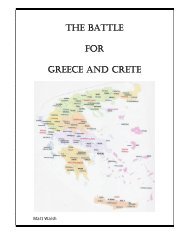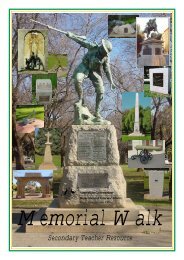Eastern Adelaide Teacher resource.pdf - Army Museum of South ...
Eastern Adelaide Teacher resource.pdf - Army Museum of South ...
Eastern Adelaide Teacher resource.pdf - Army Museum of South ...
Create successful ePaper yourself
Turn your PDF publications into a flip-book with our unique Google optimized e-Paper software.
www.awm.gov.au > Biographical Databases> Nominal Rolls > Boer War<br />
Nominal Roll<br />
Enter the name Waite and click on search. Find out in which contingents,<br />
Corporal and subsequently Lieutenant W.C.N. (William Charles Nightingale)<br />
Waite served?<br />
1 (MNTD RIFLES) CNTGNT and 6 (IMPERIAL) CNTGNT<br />
(9) During the First World War, Lieutenant Colonel Waite served as an<br />
artillery <strong>of</strong>ficer at Gallipoli and on the Western Front (France and<br />
Belgium), where he won a number <strong>of</strong> military honours. By accessing the<br />
Australian War Memorial website at<br />
www.awm.gov.au > Biographical Databases > Honours and Awards > Honours<br />
and Awards (Recommendations: First World War)<br />
Enter his surname and click on search. Locate the record for W.C.N. (William<br />
Charles Nightingale) Waite. Click on the recommendation to find out why he<br />
won the Distinguished Service Order (DSO).<br />
The recommendation reads “For specially meritorious service and devotion to duty as<br />
an Artillery Group Commander in FRANCE, from June 1916 to February 25 th 1917”<br />
and then provides further details <strong>of</strong> the achievements <strong>of</strong> the artillery battery under his<br />
command.<br />
<strong>Teacher</strong>s note: <strong>Teacher</strong>s may wish to explain that accurate and timely artillery fire<br />
was crucial to the success or failure <strong>of</strong> most large scale attacks on enemy positions<br />
during World War I. Techniques for firing artillery improved throughout the war and<br />
the process <strong>of</strong> planning artillery support became extremely sophisticated. This<br />
generally involved many types <strong>of</strong> guns firing simultaneously to provide defensive<br />
barrages for advancing troops and to bombard a range <strong>of</strong> enemy targets. These<br />
included enemy artillery positions, which could be detected by the flashes that<br />
emanated from their barrels when they were fired.<br />
(10) One surname that appears five times on the large Burnside Council<br />
Honour Roll is Sando. Two <strong>of</strong> the soldiers, S.J and L.H Sando, have a cross<br />
next to their names. By accessing the Australian War Memorial’s website<br />
at<br />
www.awm.gov.au > Biographical Databases > Roll Of Honour<br />
Enter the name Sando, select First World War, 1914 -1918 and ‘click’ on search.<br />
Locate the records <strong>of</strong> these two men and from the ‘Circular Information” find<br />
out the following;<br />
What age was he Sydney Joseph Sando when he lost his life?<br />
19 years and 10 months<br />
10











